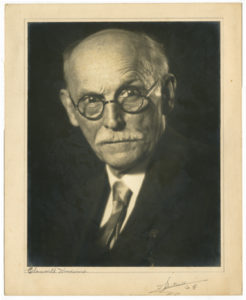Ellsworth Woodward
Louisiana artist Ellsworth Woodward was a pillar of the New Orleans art scene as a teacher and a promoter between 1890 and 1940.

Courtesy of The Historic New Orleans Collection.
Joseph Woodson Whitesell shot this portrait of fellow artist, Ellsworth Woodward in 1935.
As a teacher, artist, and promoter, Ellsworth Woodward was a pillar of the New Orleans art scene between 1890 and 1940. He painted in an impressionist style all his life but, though his work was popular, his primary influence was as teacher and institution builder. He is particularly known as one of the founders of Newcomb Pottery at Sophie Newcomb College (now part of Tulane University) in New Orleans. A proponent of the Arts and Crafts movement, popular in the late nineteenth and early twentieth centuries, Woodward advocated local crafts as an alternative to standardized, machine-made wares.
Born July 14, 1861, in Seekonk, Massachusetts, Ellsworth was one of two artistic brothers born into the Woodward family, the other being his older brother, William Woodward. Educated at the Rhode Island School of Design, Ellsworth also studied abroad briefly in Munich, under Carl Marr and Richard Fehr. He arrived in New Orleans in 1885, where he joined his brother on the art faculty at Tulane. Two years later, he became professor of art at Sophie Newcomb College, a position he held until his retirement in 1931.
Woodward and the Arts and Crafts Movement
Influenced by the ideals of the Arts and Crafts movement, popular in the late nineteenth and early twentieth centuries, Woodward was concerned with the effects of industrialization and machine manufacturing on aesthetics. As an alternative, he advocated social uplift through the creation of beautiful handcrafted objects for everyday use. “The world is full of a number of things,” he once asserted, “but none of them is more certain than that art and handicraft are Siamese twins.” Moreover, Woodward emphasized the primacy of locale among artist and subject alike. Only people raised in and shaped by a specific place, he believed, could adequately convey its natural beauty. “The beginnings of all great …epochs of artistic expression,” he insisted, “have been at home and have dealt with life and environment as it lay at hand.”
During his long career, Woodward promoted his aesthetic idealism through substantial organizational service. In 1900, he established the New Orleans Art Association. Twelve years later, he chaired the art committee at the newly established Isaac Delgado Museum of Art (now the New Orleans Museum of Art) and became its president in 1924. In 1920, he cofounded the Southern States Art League, over which he presided from 1926 to 1933. But the pottery he established on the Newcomb campus in 1895 remains both his longest and best known attempt to institutionalize his vision of art and society.
Woodward and Newcomb Pottery
Newcomb Pottery, as it came to be known, combined Woodward’s commitment to the Arts and Crafts movement with his belief in the power of localized art. The form itself was all but guaranteed to avoid the standardized regularity of machine manufacturers. Pottery was not only an ancient craft but also highly individualized at every step in the production process. Kiln fluctuations, local clay recipes, and the glazing process all combined to make each piece a unique object, nearly impossible to duplicate. In addition, Woodward explained, the process was “wholly indigenous.” The clay was from St. Tammany Parish, while “the designers are Southern women educated in the School of Art of Newcomb College, New Orleans; the land of the orange and palm, the magnolia and jasmine, the bearded cypress, the noble oak, and the stately palm.” Their designs would thus marry material, subject, and maker, a process certain to create, in Woodward’s estimation, “the most perfect expressions of locality.”
Under his tutelage, and with a coterie of assistants that eventually included Joseph Meyer, George Ohr, Mary Sheerer, and Paul Cox, Woodward’s local experiment gained world renown. In 1907, the judges of Jamestown, New York, arts and crafts fair awarded Newcomb Pottery its Gold Prize. Eight years later, at the Panama-Pacific Exhibition in San Francisco, it won five separate awards, including two grand prizes. The distinctions helped make Newcomb the second-largest producer of individually decorated pottery in America (only the famous Rookwood Pottery in Cincinnati was bigger).
Significance/Legacy
Ironically, international acclaim undermined Woodward’s aesthetic purpose in a fundamental way. As a result of its soaring popularity, orders swamped Newcomb, forcing it to operate faster, and much closer to factory production, than Woodward found comfortable. Expanded demand also undermined design innovation, ultimately resulting in the standardization of a small group of popular decorations. Then, too, the international reputation of the pottery meant that its products usually became rarefied objects of elite art collections rather than objects of everyday use.
Two years after his retirement in 1933, amid the deepening Depression, Woodward accepted appointment as a regional director of the Public Works of Art Project, the first New Deal experiment in patronizing art. Funded by the Civilian Works Agency, Woodward’s Region Six employed artists working in Louisiana, Arkansas, Mississippi, and Alabama, an experience he often found frustrating. He not only agonized between the desire to help needy artists and his determination to maintain standards of artistic excellence, but also resented the nationalizing trends of federal art patronage. Though clearly whipsawed between skill and need, his commitment to Arts and Crafts idealism, a belief in a better society achieved through the fine arts, outweighed any compulsion to feed starving artists of questionable talent, even among former students. Likewise, this lifelong aesthetic localist resented Works Projects Administration plans to create a national art community through federal patronage and organizations, a criticism voiced in one of his last public statements. Ellsworth Woodward died in New Orleans in 1939. His work is in the collections of the Louisiana State Museum in New Orleans, the Morris Museum in Augusta, Georgia, and the Museum of Fine Art in Houston, Texas. The Newcomb Art Gallery also owns several works.
